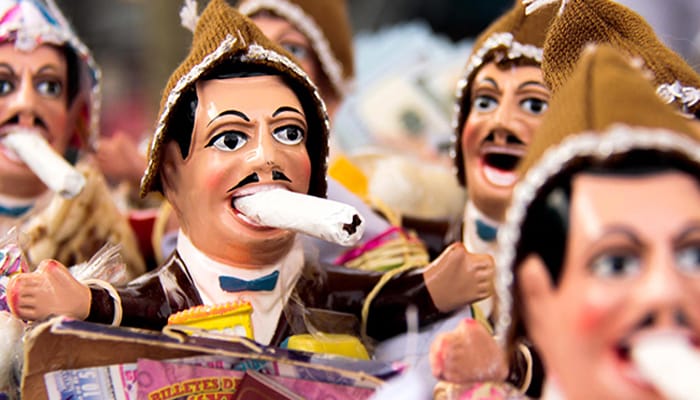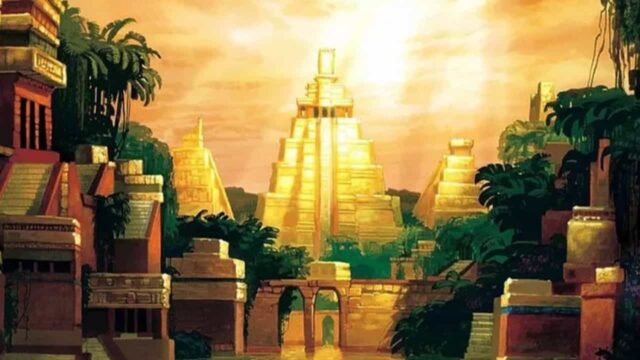Ekeko is the Tiwanakan (pre-Columbian civilization) god of abundance and prosperity in the mythology and folklore of the Andean highlands. His main importance in popular culture is as the main figure of the annual Alasitas fair, a cultural event held every January 24 in La Paz, Bolivia.

Ekeko is a wooden figurine similar to Omamori, representing a traditional and popular god of luck in Bolivia and neighboring regions, such as southeastern Peru, northern Argentina, and northern Chile. In 1781, the indigenous peoples led by Tupac Katari rebelled against Spanish rule and laid siege to the city of La Paz, where Paulita Tintaya, of Aymara descent, was a slave to the wife of the governor and commander of the army of La Paz, Doña Josefa de Rojas.
The girl was in love with another servant, Isidro Choquehuanca, also Aymara, who had to stay on the master’s farm. Isidro had given Paulita an amulet consisting of a clay figure in the shape of Don Sebastián de Rojas, her master and Doña Josefa’s father, who was a very short, fat, jovial Spaniard with a red face.
1. Etymology
The name Ekeko comes from a variation of the original expression Ekhako or Eqaqo, known as Ekhekho, who was the traditional god of prosperity in the Qullasuyu. The Ekhako were often invoked when misfortune disturbed their homes.
2. Characteristics
Ekeko is represented as a man with a mustache dressed in traditional Andean clothing (especially the poncho) and completely laden with bags and baskets of grains and food (compared to the cornucopia of some Greco-Roman deities), household objects, and banknotes, and basically everything that a person is believed to want or need to have a comfortable and prosperous life.
He is commonly found as a small statue placed somewhere in the home, preferably in a comfortable spot, but also as an amulet attached to key chains; modern statues of the god include a circular opening in the mouth where a cigarette can be placed for Ekeko’s enjoyment. The latest tradition is that Ekeko “smokes” a lit cigarette once a year to ensure a full year of prosperity.
3. Purpose
Ekeko brings monetary wealth to his followers. An offering is usually required before he will lend his services. Banknotes are often cut out and offered to Ekeko, but some figurines allow a cigarette to be lit as an offering.
Figures that allow cigarette offerings have mouth openings large enough for cigarettes to be inserted. In addition, Ekeko provides good harvests when grain is offered.
4. Bolivian Myths – The Ekeko
After months of siege, the people of La Paz found themselves in a desperate situation, as food and water were scarce. They even had to eat cats and dogs to avoid starvation. Only in Paulita’s kitchen was there always food, thanks to the clay figure she had placed on a small altar, which had miraculously provided the maid with enough dried meat, corn, and biscuits.
In reality, it was Isidro who had given her these provisions, as he was in the indigenous army and could therefore enter the city secretly. When Doña Josefa fell ill from malnutrition, Paulita decided to share her food with her and the governor, who wanted to know where she had got it from. She told Governor Segurola that it was the clay figure, whom she called Ekeko.
She had the power to make food appear when needed, and she did not want to put Isidro at risk of being caught and tortured. The entire household survived the long six months of siege thanks to Paulita’s food, and when the Spanish army sent a regiment to help the city, the indigenous army fled.
Grateful for this “miracle,” Governor Segurola and his wife gave their blessing to Paulita and Isidro’s wedding and took them both into their home as servants. Neither of them ever forgot the smiling little man who had meant salvation during the harsh siege, and they created a small altar for him in their home. Much later, people began to use imitations of this clay figure as a symbol of abundance, generosity, and happiness.
Today, people celebrate Ekeko as the god of abundance in an annual festival in La Paz that begins on January 24 called Alasitas. This festival is also celebrated in other regions of the country, such as Santa Cruz, where it takes place in September or October. Here, people buy miniatures of everything they want Ekeko to give them during the coming year and attach the miniatures to their ponchos.
The legends and stories of the figures known as Ekeko, described by scholar Antonio Díaz Villamil, date back to 1781 in Bolivia. At that time, the city of La Paz was surrounded by natives who were still at war with the Spanish conquistadors.
The story of Ekeko’s origin begins with a girl named Paulita Tintaya, who earned her living working for a landowner named Josefa Ursula de Rojas Foronda. The little girl was in love with a man named Isidoro Choquehuanca.
Years earlier, she had left the estate where they had both grown up. Before she left, Isidoro gave her a small statue to protect her. This small statue was the Ekeko, which was popular among the Andean natives as a god of luck and fortune.
At the time of the siege, people were dying of hunger. Isidoro enlisted in the indigenous army and managed to return to Paulina’s home. Every week, he placed food next to the statue, which was located outside the house, but no one knew he was doing it.
That is the origin of the belief in Ekeko’s powers to provide abundance. Central role in the Alasitas festival
Other stories
Many years before the Spanish conquest of South America, a man named Aymara Iqiqu lived on the Andean plateau. He was short, humble, generous, cheerful, and festive. His kindness was such that wherever he went, he brought harmony, established good relationships, and pacified lovers. He could also give useful advice, and his mere presence guaranteed happy days for everyone.
Iqiqu went down in history as Ekeko and took his place in the pantheon as the spirit of abundance and prosperity of the Inca Aymara culture. Tradition dictates that whoever brings home a painting of this character, duly consecrated and worshipped with simple offerings, will defeat poverty, will never lack daily bread, and will see all their wishes come true, without forgetting to honor the statue with fruit, sweets, coins, strong liquor, and cigarettes for the inevitable Ekeko to smoke.
The Ekeko figures from Il Crogiuolo are original, entirely handmade and crafted using traditional methods. No two are alike in expression, colors, or finish. All come from the Andean region and are baked by hand in a wood-fired oven. In addition to being valuable esoteric items, they are distinguished by their beauty and precision finish.
5. Another artistic impression of an Ekeko in Bolivia.
The Alasitas festival is held and presented by the Ekeko every January 24 in La Paz. People attend the event from all over the city and even travel from other cities within Bolivia to buy miniature versions of the products to give to others, in the hope that the recipient will receive the real item during the coming year.
In other regions, the Ekeko festival is celebrated in October and is known as Calvario. In 2009, Bolivia asked the United Nations to recognize the Bolivian cultural roots of the Alasitas festival, celebrating the figure of Ekeko, something that Peru also claims. However, the Bolivian ambassador to Peru, Franz Solano, acknowledged that the doll was present in both countries.
6. Ekeko today
They are a wonderful gift to give to people you love. Some merchants sell the Ekeko statue together with a complete consecration kit including the history of this mysterious character, his mysterious powers and prayers, his blessing, and the ritual instruments to bring him to life in this powerful spirit according to the Inca Andean tradition.

